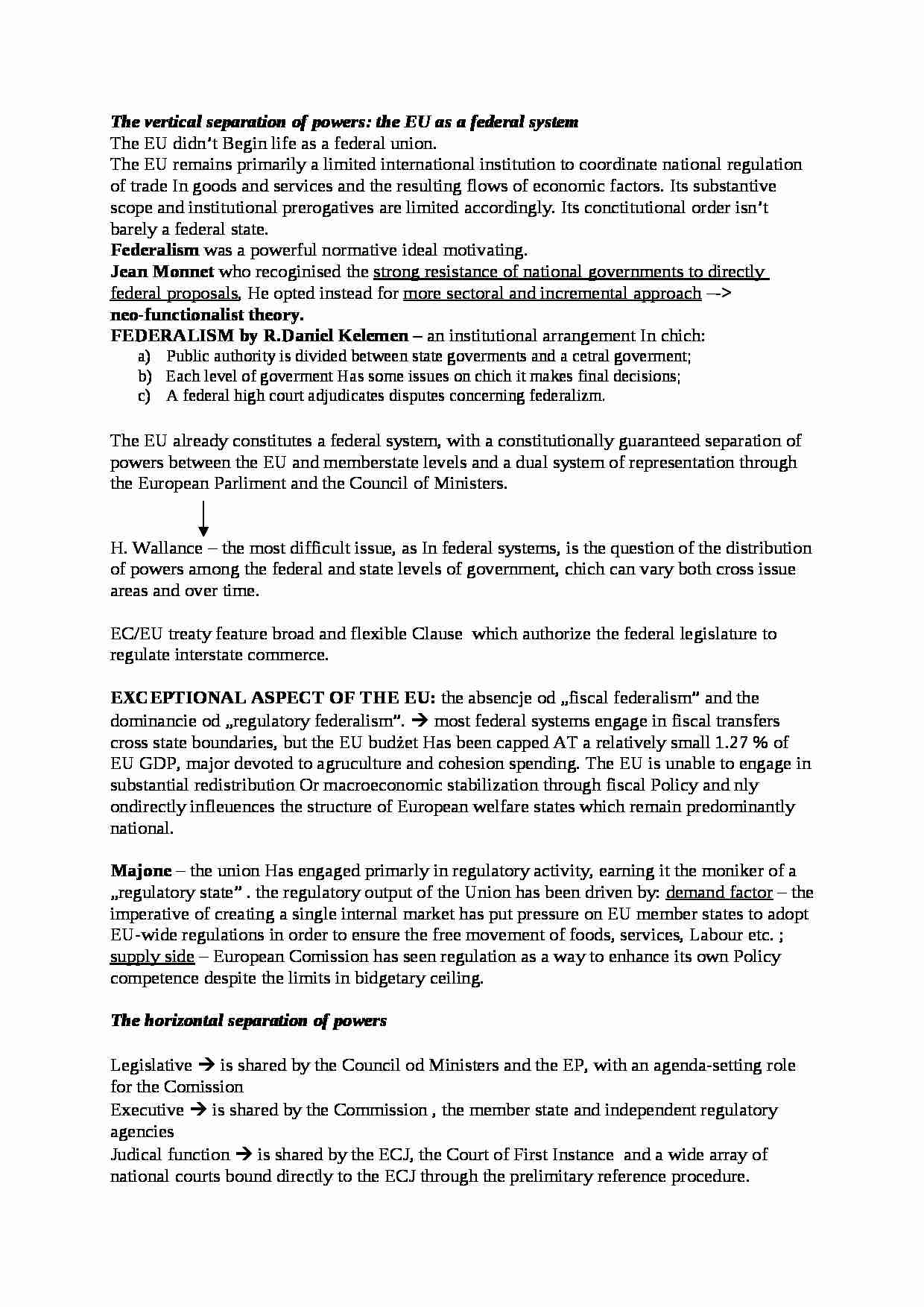To tylko jedna z 2 stron tej notatki. Zaloguj się aby zobaczyć ten dokument.
Zobacz
całą notatkę


The vertical separation of powers: the EU as a federal system
The EU didn't Begin life as a federal union.
The EU remains primarily a limited international institution to coordinate national regulation of trade In goods and services and the resulting flows of economic factors. Its substantive scope and institutional prerogatives are limited accordingly. Its conctitutional order isn't barely a federal state.
Federalism was a powerful normative ideal motivating. Jean Monnet who recoginised the strong resistance of national governments to directly federal proposals, He opted instead for more sectoral and incremental approach -- neo-functionalist theory.
FEDERALISM by R.Daniel Kelemen - an institutional arrangement In chich:
Public authority is divided between state goverments and a cetral goverment;
Each level of goverment Has some issues on chich it makes final decisions;
A federal high court adjudicates disputes concerning federalizm.
The EU already constitutes a federal system, with a constitutionally guaranteed separation of powers between the EU and memberstate levels and a dual system of representation through the European Parliment and the Council of Ministers. H. Wallance - the most difficult issue, as In federal systems, is the question of the distribution of powers among the federal and state levels of government, chich can vary both cross issue areas and over time.
EC/EU treaty feature broad and flexible Clause which authorize the federal legislature to regulate interstate commerce.
EXCEPTIONAL ASPECT OF THE EU: the absencje od „fiscal federalism” and the dominancie od „regulatory federalism”. most federal systems engage in fiscal transfers cross state boundaries, but the EU budżet Has been capped AT a relatively small 1.27 % of EU GDP, major devoted to agruculture and cohesion spending. The EU is unable to engage in substantial redistribution Or macroeconomic stabilization through fiscal Policy and nly ondirectly infleuences the structure of European welfare states which remain predominantly national.
Majone - the union Has engaged primarly in regulatory activity, earning it the moniker of a „regulatory state” . the regulatory output of the Union has been driven by: demand factor - the imperative of creating a single internal market has put pressure on EU member states to adopt EU-wide regulations in order to ensure the free movement of foods, services, Labour etc. ; supply side - European Comission has seen regulation as a way to enhance its own Policy competence despite the limits in bidgetary ceiling.
The horizontal separation of powers
Legislative is shared by the Council od Ministers and the EP, with an agenda-setting role for the Comission
(…)
… officials in the Council and its subsidiary committees and working groups. Inter-institutional relations among the Comission (as agenda-setter) and the Council and Parliament, under different legislatives procedures. Between 1980s - 1990s the legislative powers of the EP have grown, from relatively Modest and non-binding `consultation procedure' to creation and reform of a `co-decision procedure'. The institutional Power and impast of the Ep on legislative outcomes has grown substantinally over time wityh the move from consulation to cooperation to the two different versions of co-decision in the Maastricht and Amsderdam Treaties.
Executive politics: delegation and discretion
The European Commission
The European Central Bank
EU agencies
Trans action-cost accounts of delegation argue that member-state…
… an MEP's `party group' with the various party groups demonstrating extraordinarrily high measures of cohension in roll-call votes. These MEP's were show to contess elections and cast their votes in a two-dimansional `issue space', including not only the familiar nationalism/supranationalism dimension but also more traditional dimension of left-right contenstation EP as a `normal parliament…
... zobacz całą notatkę




Komentarze użytkowników (0)